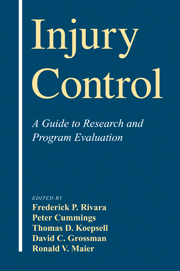Book contents
- Frontmatter
- Contents
- List of Contributors
- 1 An Overview of Injury Research
- 2 Classifying and Counting Injury
- 3 Measurement of Injury Severity and Co-morbidity
- 4 Data Linkages and Using Administrative and Secondary Databases
- 5 Rates, Rate Denominators, and Rate Comparisons
- 6 Data Collection Methods
- 7 Selecting a Study Design for Injury Research
- 8 Qualitative Methods in Injury Research
- 9 Randomized Trials
- 10 Cohort Studies in Injury Research
- 11 Case–Control Studies in Injury Research
- 12 Ecologic Studies
- 13 Case Series and Trauma Registries
- 14 Systematic Reviews of Injury Studies
- 15 Evaluating an Injury Intervention or Program
- 16 The Development of Clinical Decision Rules for Injury Care
- 17 Trauma Performance Improvement
- 18 Measuring Disability and Quality of Life Postinjury
- 19 Economic Evaluation of Injury Control
- 20 Ethical Issues
- Index
9 - Randomized Trials
Published online by Cambridge University Press: 16 October 2009
- Frontmatter
- Contents
- List of Contributors
- 1 An Overview of Injury Research
- 2 Classifying and Counting Injury
- 3 Measurement of Injury Severity and Co-morbidity
- 4 Data Linkages and Using Administrative and Secondary Databases
- 5 Rates, Rate Denominators, and Rate Comparisons
- 6 Data Collection Methods
- 7 Selecting a Study Design for Injury Research
- 8 Qualitative Methods in Injury Research
- 9 Randomized Trials
- 10 Cohort Studies in Injury Research
- 11 Case–Control Studies in Injury Research
- 12 Ecologic Studies
- 13 Case Series and Trauma Registries
- 14 Systematic Reviews of Injury Studies
- 15 Evaluating an Injury Intervention or Program
- 16 The Development of Clinical Decision Rules for Injury Care
- 17 Trauma Performance Improvement
- 18 Measuring Disability and Quality of Life Postinjury
- 19 Economic Evaluation of Injury Control
- 20 Ethical Issues
- Index
Summary
Introduction
A randomized trial is a comparative study in which subjects are assigned among alternative intervention strategies according to random chance. It is a relatively new tool in health research. The first clinical trial involving randomization of individual patients, reported in 1948, compared streptomycin with bed rest for pulmonary tuberculosis (Medical Research Council, 1948). Since then, it is estimated that over 300,000 randomized trials have been conducted (Randal, 1999).
This chapter seeks to orient the injury researcher to important methodologic issues in applying the randomized trial design, to illustrate how the design has been applied in injury research, and to provide entry points into the literature on randomized trial methodology. More information can be found in several good books (Pocock, 1983; Meinert, 1986; Chow and Liu, 1998; Friedman et al., 1998).
Prototype Design
The term randomized trial encompasses a family of designs. Probably the simplest version is a two-arm, parallel-groups randomized trial, shown in Figure 9.1. Potential study subjects are identified from a source, such as patients receiving care from a certain provider or hospital. Those who satisfy criteria for eligibility are informed about the trial and invited to participate. Consenting subjects are assigned at random to one of two intervention strategies (arms), and are monitored over time to measure the incidence of good and bad outcomes.
An example of this study design was the Prevention of Falls in the Elderly Trial (PROFET), conducted by Close et al. (1999). Over a 7-month period, 1031 elderly Londoners who visited an accident and emergency department after having fallen were screened for eligibility. Patients who were institutionalized, had dementia, did not speak English, could not be re-contacted, or declined consent were excluded.
Keywords
- Type
- Chapter
- Information
- Injury ControlA Guide to Research and Program Evaluation, pp. 116 - 128Publisher: Cambridge University PressPrint publication year: 2000



